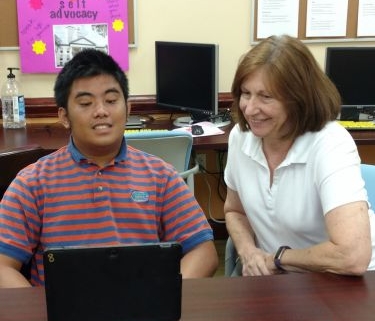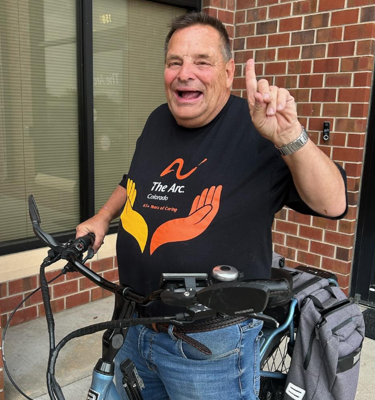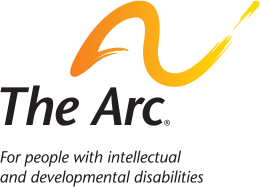How and Why to Celebrate National Disability Employment Awareness Month
 Each October, National Disability Employment Awareness Month (NDEAM) is a chance to highlight a truth that should guide us year-round: people with disabilities belong in every workplace.
Each October, National Disability Employment Awareness Month (NDEAM) is a chance to highlight a truth that should guide us year-round: people with disabilities belong in every workplace.
At The Arc, we see every day how hard people fight for that simple truth. People with disabilities, including those with intellectual and developmental disabilities (IDD) such as autism, Down syndrome, and cerebral palsy, are too often shut out of jobs, despite bringing talent, dedication, and fresh perspectives. Only about 37% of working-age people with disabilities are employed, compared with 75% of people without disabilities. Many people with disabilities are excluded before they even get a chance. For people with IDD, the barriers are often even steeper, with employment rates lagging behind the broader disability community because of bias, limited access to training, and lack of employer support.
We know the difference it makes when employers get it right. Across The Arc’s network, we see companies that build inclusive practices not only welcoming talented employees but also improving retention, morale, and innovation across their teams. Research backs this up: companies that prioritize disability inclusion outperform their peers financially.
How to Celebrate NDEAM in October (and Beyond)
NDEAM is not just about recognition. It’s about action. Here are some practical steps that can help move us toward lasting inclusion.
1. Learn About the Value of Disability Inclusion
Here’s some of the evidence showing how inclusive workplaces thrive.
- Companies That Lead in Disability Inclusion Outperform Peers Financially (Accenture)
- 2024 Disability Index Report (Disability:IN)
- The Business Benefits of Hiring People with Disabilities (Forbes)
- 7 Tips for Successfully Hiring Talent with Developmental Disabilities (SHRM)
- Accommodations Cost Less Than You Think and Have a High, Positive Impact (Job Accommodation Network)
Accommodations and workplace supports designed for employees with disabilities benefit everyone. Flexible schedules, remote work options, clear communication practices, and accessible technology improve productivity and morale across the board. Inclusion creates workplaces where all employees can do their best work.
2. Share Employment Stories
Nothing shifts attitudes faster than real stories. We’ve seen how a single story about an employee thriving in their role can change the way a whole company thinks about disability. That’s why sharing matters. If you know someone with a disability who works, invite them to share their experience. If you’re an employer, highlight the contributions of employees with disabilities in your newsletter or on social media using #NDEAM. Encourage your local media to feature these stories to broaden public understanding.
For inspiration, explore The Arc’s archive of disability employment success stories. These real-world examples show how people with IDD are thriving at work and how employers benefit from inclusive hiring.
3. Review Your Company’s Hiring Practices
Inclusive workplaces don’t happen by accident. They are built with intention. Ask yourself:
- Do our recruiting and onboarding practices welcome candidates with disabilities?
- Are our policies aligned with the Americans with Disabilities Act (ADA)?
- Do HR staff, managers, and anyone who participates in interviews receive training on implicit bias and disability inclusion?
Here are some practical steps to make hiring more inclusive:
- Make your application system accessible (i.e., screen-reader friendly forms, alt text, clear language).
- Review job descriptions to remove unnecessary requirements and focus on core skills only.
- Post job openings with disability organizations and job boards that reach candidates with disabilities.
- Offer multiple interview formats and clearly state that accommodations are available.
- Participate in Disability Mentoring Day (the third Wednesday in October) as a way to connect with potential candidates and build better practices.
Not sure where to start? The Arc’s Starter Guide to Creating an Inclusive Workplace lays out 7 practical, achievable actions your company can take.
4. Invest in Long-Term Change
Real inclusion requires more than awareness—it requires resources. Consider:
- Partnering with local organizations that support people with disabilities or disability employment.
- Funding workforce development programs for people with IDD.
- Advocating for policies that expand access to competitive, integrated employment.
And remember, change at scale happens through sustained investment. By supporting The Arc, you help advance policy reforms, resources, and programs that open doors to employment for people with IDD.
This Year’s Theme & What’s New
Each year, the U.S. Department of Labor’s Office of Disability Employment Policy sets a theme for National Disability Employment Awareness Month. This year’s theme is “Celebrating Value and Talent.” It’s a reminder of the value and talent people with disabilities bring to our workplaces and economy.
Across the country, many companies are rolling back diversity initiatives. But here’s the risk: treating disability inclusion as a political issue rather than a business imperative misses the point.
Hiring people with disabilities isn’t about checking a DEI box. It’s about building stronger teams, increasing retention, and better reflecting your customers and communities. Companies like Microsoft and SAP have shown that employees with disabilities are among the most creative and valuable assets to their organizations.
The bottom line is inclusion pays off. When businesses shy away from disability hiring, they’re leaving talent, innovation, and profit on the table.
Why NDEAM Matters
The disability community has waited too long for true equity in employment. For people with intellectual and developmental disabilities, the barriers are often even higher. NDEAM can’t just be a hashtag once a year. It has to be the spark for bigger change: updating hiring practices, removing barriers, and reshaping workplaces so that everyone has the chance to thrive. That’s the work The Arc has led for more than 75 years, and it’s the work ahead for all of us.





 The killing of Ryan Gainer, a Black autistic teen, is a devastating injustice. Too many people with disabilities, especially those from marginalized communities, cannot access the crisis intervention services they need. In the face of Ryan’s mental health crisis, his family called 911 for help. Instead of receiving the care he needed from a competent professional, he was killed. Because of the tragedy of Ryan’s death and the death of others before him, The Arc’s National Center on Criminal Justice & Disability is working to reform our public safety practices across the country. This center offers comprehensive training to improve crisis response for people like Ryan. Our hearts go out to the Gainer family and all those who loved Ryan. We pledge to continue to keep working for a just, equitable world for all people with disabilities.
The killing of Ryan Gainer, a Black autistic teen, is a devastating injustice. Too many people with disabilities, especially those from marginalized communities, cannot access the crisis intervention services they need. In the face of Ryan’s mental health crisis, his family called 911 for help. Instead of receiving the care he needed from a competent professional, he was killed. Because of the tragedy of Ryan’s death and the death of others before him, The Arc’s National Center on Criminal Justice & Disability is working to reform our public safety practices across the country. This center offers comprehensive training to improve crisis response for people like Ryan. Our hearts go out to the Gainer family and all those who loved Ryan. We pledge to continue to keep working for a just, equitable world for all people with disabilities.
 Kris lives with his sister’s family in his hometown of Greely, Colorado, and has been successfully employed for 40 years, currently working full time at the busiest grocery store in town. He is an avid sports fan—Go Bears!—has a busy social life, and because of his gregarious personality he is a bit of a local celebrity, traveling around town on his e-bike. Kris has become very active in civic service—involved with the Chamber of Commerce, volunteering at local nonprofits, and serving in leadership roles at both The Arc of Weld County and on The Arc’s National Council of Self-Advocates.
Kris lives with his sister’s family in his hometown of Greely, Colorado, and has been successfully employed for 40 years, currently working full time at the busiest grocery store in town. He is an avid sports fan—Go Bears!—has a busy social life, and because of his gregarious personality he is a bit of a local celebrity, traveling around town on his e-bike. Kris has become very active in civic service—involved with the Chamber of Commerce, volunteering at local nonprofits, and serving in leadership roles at both The Arc of Weld County and on The Arc’s National Council of Self-Advocates. Roselyn has lived with her mother and received support from The Arc of Greater Indianapolis since 1981. During the week, Roselyn works at Corteva Agriscience through The Arc of Greater Indianapolis’ employment services. She works as part of a team that assists scientists in preparing seedling trays for growing new plants, hosing down trays when experiments are complete, and keeping the greenhouse labs clean. Roselyn is very proud of her work and the independence she has from earning a paycheck. She recently bought a kitchen table set and used her tax check to buy a new washer and dryer.
Roselyn has lived with her mother and received support from The Arc of Greater Indianapolis since 1981. During the week, Roselyn works at Corteva Agriscience through The Arc of Greater Indianapolis’ employment services. She works as part of a team that assists scientists in preparing seedling trays for growing new plants, hosing down trays when experiments are complete, and keeping the greenhouse labs clean. Roselyn is very proud of her work and the independence she has from earning a paycheck. She recently bought a kitchen table set and used her tax check to buy a new washer and dryer.









